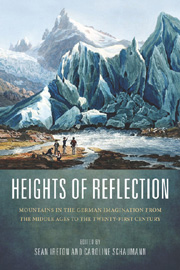 Heights of Reflection
Heights of Reflection Book contents
- Frontmatter
- Contents
- Acknowledgments
- Introduction: The Meaning of Mountains: Geology, History, Culture
- Prelude: Classical Mountain Landscapes and the Language of Ascent
- Part I First Forays: Mountain Exploration and Celebration from the Middle Ages to the Eighteenth Century
- Part II Beckoning Heights: Summits Near and Far in the Nineteenth Century
- Part III Modern Expeditions and Evocations: Climbing from the Twentieth into the Twenty-First Century
- Leaving the Summit Behind: Tracking Biographical and Philosophical Pathways in Richard Strauss's Eine Alpensinfonie
- Elevation and Insight: Thomas Mann's Der Zauberberg
- “The Essence of the Alpine World Is Struggle”: Strategies of Gesundung in Arnold Fanck's Early Mountain Films
- “Mountain of Destiny”: The Filmic Legacy of Nanga Parbat
- Spatial Orientation and Embodied Transcendence in Werner Herzog's Mountain Climbing Films
- W. G. Sebald's Magic Mountains
- Conflicting Ascents: Inscriptions, Cartographies, and Disappearance in Christoph Ransmayr's Der fliegende Berg
- Works Cited
- Notes on the Contributors
- Index
Conflicting Ascents: Inscriptions, Cartographies, and Disappearance in Christoph Ransmayr's Der fliegende Berg
from Part III - Modern Expeditions and Evocations: Climbing from the Twentieth into the Twenty-First Century
Published online by Cambridge University Press: 05 February 2013
- Frontmatter
- Contents
- Acknowledgments
- Introduction: The Meaning of Mountains: Geology, History, Culture
- Prelude: Classical Mountain Landscapes and the Language of Ascent
- Part I First Forays: Mountain Exploration and Celebration from the Middle Ages to the Eighteenth Century
- Part II Beckoning Heights: Summits Near and Far in the Nineteenth Century
- Part III Modern Expeditions and Evocations: Climbing from the Twentieth into the Twenty-First Century
- Leaving the Summit Behind: Tracking Biographical and Philosophical Pathways in Richard Strauss's Eine Alpensinfonie
- Elevation and Insight: Thomas Mann's Der Zauberberg
- “The Essence of the Alpine World Is Struggle”: Strategies of Gesundung in Arnold Fanck's Early Mountain Films
- “Mountain of Destiny”: The Filmic Legacy of Nanga Parbat
- Spatial Orientation and Embodied Transcendence in Werner Herzog's Mountain Climbing Films
- W. G. Sebald's Magic Mountains
- Conflicting Ascents: Inscriptions, Cartographies, and Disappearance in Christoph Ransmayr's Der fliegende Berg
- Works Cited
- Notes on the Contributors
- Index
Summary
All hell didn't break loose, it was like a rising psalm materializing like snow on an unseen mountain. All that was underfoot was good, but lost.
— John Ashbery, Where Shall I Wander (2005)Can extreme mountaineering provide helpful allegories for the risks of vertiginous reading? Can a literary work of art, and in turn its reader, temporarily be understood to undergo tectonic shifts that continuously uplift, submerge, and reassert ultimately unmappable epistemic terrain? Avoiding coarsely grained philological quicksand and leaving behind fixations on omniscient methods at hermeneutic base camps, expeditions in reading fiction can still face the challenge of telling apart the climber from the gorge, and untraceable narrators from posthuman landscapes. Could the solitary or synergistic process of reading connote a free-climbing experience, comprising tentative conceptual ascents that navigate across or around petrified dichotomies of conquest and selflessness, of conceptual control and self-abandon? The novel under discussion in this chapter at once thematizes these epistemic conflicts and offers itself as a territory that invites intersecting inscriptions of reading routes.
Rather than signifying sublime permanence in contrast to the vulnerable human body, the mythical Phur-Ri, a fictional, roughly 7,000 meter high Tibetan mountain that is the target of two Irish brothers' expedition in Christoph Ransmayr's Der fliegende Berg (The flying mountain, 2006) emerges as a transient phenomenon. Phur-Ri temporarily disappears and is believed by natives to occasionally fly upward until it descends and becomes visible again.
- Type
- Chapter
- Information
- Heights of ReflectionMountains in the German Imagination from the Middle Ages to the Twenty-First Century, pp. 334 - 348Publisher: Boydell & BrewerPrint publication year: 2012
